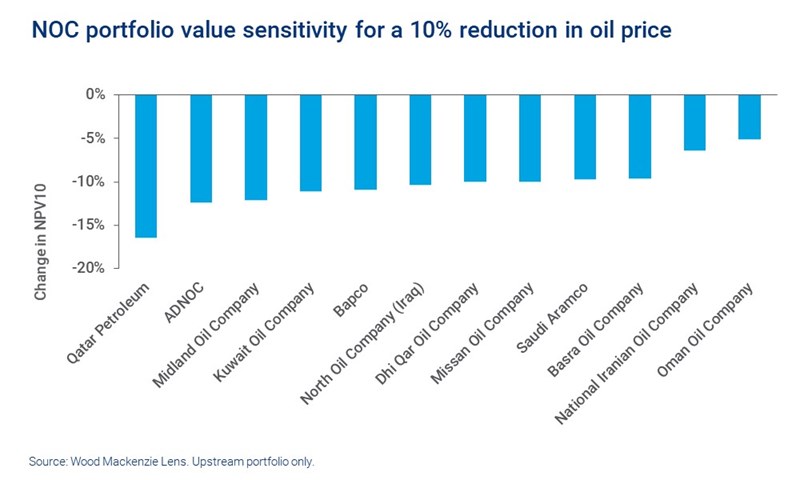Middle East oil & gas operators in a better position to weather the storm than global peers
But expect project delays and budget cuts as producers tighten their belts
1 minute read
Ian Thom
Research Director, Upstream

Ian Thom
Research Director, Upstream
Ian brings 18 years of experience to his role as head of regional analysis for Europe, Russian, Caspian and Africa
Latest articles by Ian
-
Opinion
Video | Lens Emissions: Africa’s oil – legacy fields vs low-carbon future
-
Opinion
Namibia faces setback as Shell downgrades oil discoveries
-
Featured
Upstream oil & gas regions 2025 outlook
-
Opinion
ADNOC acquires stake in Rovuma LNG from Galp
-
Opinion
Global upstream: the biggest topics
-
Opinion
Africa’s Energy Hotspots – three trends that will shape the next decade of African energy
As oil revenues collapse, country finances are looking bleak. A prolonged loss of revenue from low prices will cause significant economic harm to Middle East petro-states – especially those that don’t have a sovereign wealth fund. And if demand falls further as the coronavirus pandemic continues, pressure will intensify.
Governments, national oil companies (NOCs) and international oil companies (IOCs) are urgently reassessing their 2020 operating, investment and financing plans. The Middle East’s low-cost base provides a huge advantage relative to other producing regions – but government revenues are heavily dependent on oil and gas.
How will the region fare through the crisis?
Relative to the rest of the world, the Middle East should come out of the crisis in a stronger position.

Ian Thom
Research Director, Upstream
Ian brings 18 years of experience to his role as head of regional analysis for Europe, Russian, Caspian and Africa
Latest articles by Ian
-
Opinion
Video | Lens Emissions: Africa’s oil – legacy fields vs low-carbon future
-
Opinion
Namibia faces setback as Shell downgrades oil discoveries
-
Featured
Upstream oil & gas regions 2025 outlook
-
Opinion
ADNOC acquires stake in Rovuma LNG from Galp
-
Opinion
Global upstream: the biggest topics
-
Opinion
Africa’s Energy Hotspots – three trends that will shape the next decade of African energy
How will the drop in the oil price affect revenue?
Governments in the Middle East rely on their NOCs to deliver long-term oil revenues. A 10% decrease in the oil price would reduce US$240 billion of NOC value (before adjusting for any changes to capex and production). But NOCs can mitigate revenue losses by taking measures to improve operating efficiency and reduce capital budgets.
We’ve used Wood Mackenzie Lens to map out which NOCs are most sensitive to changes in the oil price. It is no surprise that Qatar Petroleum is the most price-sensitive NOC with its investment-heavy LNG expansion plans.
Over the past decade, the Middle East has been eclipsed by US tight oil and shale gas. But now, the region is setting itself up for the longer term as the premier supplier of oil.

Ian Thom
Research Director, Upstream
Ian brings 18 years of experience to his role as head of regional analysis for Europe, Russian, Caspian and Africa
Latest articles by Ian
-
Opinion
Video | Lens Emissions: Africa’s oil – legacy fields vs low-carbon future
-
Opinion
Namibia faces setback as Shell downgrades oil discoveries
-
Featured
Upstream oil & gas regions 2025 outlook
-
Opinion
ADNOC acquires stake in Rovuma LNG from Galp
-
Opinion
Global upstream: the biggest topics
-
Opinion
Africa’s Energy Hotspots – three trends that will shape the next decade of African energy
The Middle East is under pressure, but it will fare better than others
To weather the latest crisis, governments, NOCs and IOCs will urgently need to tighten their belts.
Operators will reduce investment at fields that are in production and under development. Higher-cost projects will be under more scrutiny, and countries with budget shortfalls will be the most brutal. Several pre-FID projects could be delayed, with new investment likely to be deferred until 2021 or later.
Capex will fall, but the Middle East should be in a better position than its peers. We predict a 10-20% capex cut, in comparison to the 25% drop we expect to see over the rest of the world.
The region’s share of global capex is steadily increasing and this will reinforce its role as the leading global energy supplier.
Which Middle East pre-FID projects are most at risk of delay? Fill in the form at the top of this page to find out.








